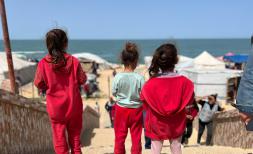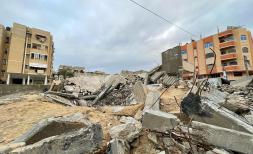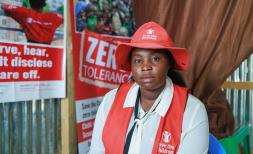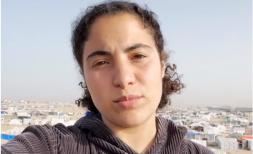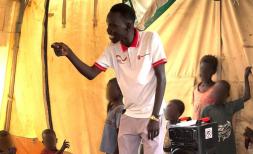What is it like to be a refugee for 30 years?

This week brings together leaders from around the world to New York City for the UN General Assembly to discuss the topic of the growing forcibly displaced population. There are 65 million forcibly displaced people, of which 21 million are refugees, and the numbers are rising. The average length of time as a refugee is now 17 years and the refugee camps along the Thai-Burma border are an example of protracted refugee crisis and the challenges refugees face. Majority of the refugee families fled in the early 80s and have been living in camps for 30 years, unable to return to their country still affected by conflict.
30 Years a Refugee
The Mae La camp, also the largest refugee settlement in Thailand, was established in 1984, at the height of Karen people fleeing Burma. It is now housing over 50,000 refugees. The Karen, one of the main ethnic groups of Burma, makes up to 90% of the population, while the 10% are from various ethnic groups.

Refugees are not allowed to step outside of their camp for any reason unless permitted by authorities. Schools with basic education are set up for children, clinics with basic health services are available and community facilities like libraries have been established. However, in order to find work, permits need to be granted and very often they result in hard labour in neighbouring farms. The pay is approximately $4/day and usually only happens during harvesting season. Option for sustaining a livelihood are limited, highlighting an issue many refugees across the world face only able to survive through a mixed of assistance and petty work.
Most children living in the camp presently were born there or migrated when they were of a very young age, ranging from 1 to 2 years old. Some parents that are involved in Save the Children’s programmes, migrated when they were still children themselves. Some have vague memories of fleeing whereas some still remember it like it was yesterday.

As told by Win Soe (pictured on the right), “I remember that I walked for three days to get to the Thai border. There were so many of us running away from the conflict. I feared for my parents’ life.”
Eh Eh Sue, the daughter of Win Soe, has never heard of the story until today, when the interview was conducted. She shared that, “Hearing now the story about my parents fleeing Myanmar and come to Thailand, it is motivation for me to work hard and improve my studies.”

Parents do not usually share their story of fleeing Myanmar with their children because they were either too traumatized by the event, or uncertain of the effects it would have on them by doing so. To children who were born and raised in these camps being a refugee has been all their lives and they do not know the country of their parents.
Education for All, No Matter Who They Are or Where They Come From
School for children like Eh Eh Sue is only extended to Grade 10, and anything thereafter requires an elaborate English examination and expensive school fees which only a handful of families can afford despite it already kept at a bare minimum. It is an illustration of the challenges refugee children face to access secondary school. Worldwide, less than 1 in 4 refugee youth enrolled in secondary school.
In the current curriculum, refugee children study Karen, Burmese, English, Math, Science, Geography and additional subjects like health, where children are taught methods to fight dengue and battle simple viruses by having a nutritious diet. The teachers in these schools are also refugees living in the camps. Through interventions by Save the Children, partners and community-based organisations, teachers were trained on teaching methodologies, lesson planning, and subject training which significantly improved the standard of learning for students in 80 schools in refugee camps across Thailand.
Eventually, many of these families will return to Myanmar, in particular to the Karen state, where they will face difficult transitions as they may have to enroll in government schools that teach in Burmese or in smaller community schools that already provide limited support.
To bridge the gap, Save the Children is working on “Convergence” education where we aspire to achieve the recognition of refugee student learning by engaging with the Myanmar government and other important actors to promote the rights to education of these children. We also advocate for the recognition of the refugee teachers and their skills so that they will be able to gain employment and contribute to Myanmar’s education upon their return.

Pla Thongsomboon, our project coordinator based out of Mae Sot in Thailand, said, “A lot of these children feel like they have no future. We are constantly informing parents about the importance of school and we recognise that the parents are the best source of motivation to ensure that their children go and stay in schools.”
She added, “As a Thai, I recognise that in Thailand, wherever they come from originally, these children are the most deprived and the most forgotten children. I believe that these children must be protected and given a chance to learn as all children should.”

Making Sure They Stay in School
Ruby Star, 8 years old and currently studying in grade 2, faces constant challenges in maintaining good grades and staying in school. He sees the challenge even more with his peers.
So Ruby Star makes it a point to study as much as he can in order to achieve beyond average results which could grant him better access to secondary education, if his family will be able to afford it.
His mother, Say Boh, said with tears in her eyes, “I am very worried about my two older sons as they did not get the same education as Ruby Star. They did not get enough study materials when they were growing up. Health is also a concern because the camp only has basic medicine. Anything serious, we have to go to the hospital outside the camp but need a camp permit and money. I tell my children to not get injured because we cannot afford it.”

This is another illustration of the challenges many refugees face to have access to essential services if the countries where they live as refugees. Many legal barriers may prevent them from accessing the health care or the education provided in public hospitals and public schools
According to data provided by education officials, children like Ruby Star are known to drop out of school between grades 4 and 10. Many of these children, especially those from poorer families, are unable to continue studying. Their parents often had never received the opportunity to learn or develop themselves. In Mae La camp, boys are more likely to drop out than girls due to the decisions to work odd jobs which usually involves physical labour where boys are favoured.
As the world continues to speak about the plight of refugees, it is imperative that we do not forget those who have fled their place of origin decades ago and the obstacles that they continue to face. If we do not address the issues in a timely and effective manner, there are outstanding consequences that these children and their families will face. No matter who these children are, or where they come from, they deserve the same opportunities as every other child. They need a good school with good teachers, the right nutrition to keep them healthy, and their rights as a child to be able to play and learn.

As world leaders meet this week in New York, we want to ensure that refugee children in Mae La camp and worldwide can have access to education. We believe that every refugee and displaced child deserves a new deal – a deal that guarantees their rights to a safe and productive life. This is why Save the Children is calling for a commitment to ensure that no refugee child is out of school for more than one month.
We are calling on host countries to commit to ensure child refugees in their countries are in school and learning. We are asking donor countries commit to funding and convening to help make education for refugee children in all countries possible.
For refugee children in Mae La camp, we also need to ensure that the education they get in Thailand would be recognized by the Myanmar government the day they may return to a country their parents fled three decades ago.
